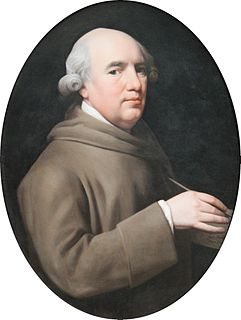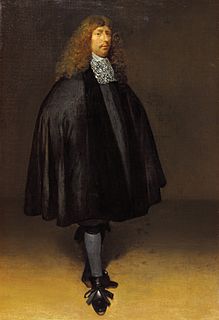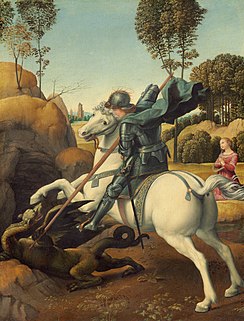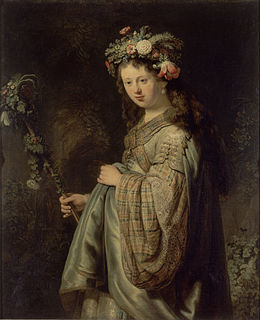
The State Hermitage Museum is a museum of art and culture in Saint Petersburg, Russia. The largest art museum in the world, it was founded in 1764 when Empress Catherine the Great acquired an impressive collection of paintings from the Berlin merchant Johann Ernst Gotzkowsky. The museum celebrates the anniversary of its founding each year on 7 December, Saint Catherine's Day. It has been open to the public since 1852. It attracted 968,604 visitors in 2020, a drop of eighty percent from 2019, due to the COVID-19 pandemic. In 2020 it ranked eleventh on the list of most visited art museums in the world.

George Stubbs was an English painter, best known for his paintings of horses. Self-trained, Stubbs learnt his skills independently from other great artists of the eighteenth century such as Reynolds or Gainsborough. Stubbs' output includes history paintings, but his greatest skill was in painting animals, perhaps influenced by his love and study of anatomy. His series of painting on the theme of a lion attacking a horse are early and significant examples of the Romantic movement that emerged in the late 18th century. His painting, Whistlejacket, hangs in the National Gallery, London.

The National Gallery of Art, and its attached Sculpture Garden, is a national art museum in Washington, D.C., United States, located on the National Mall, between 3rd and 9th Streets, at Constitution Avenue NW. Open to the public and free of charge, the museum was privately established in 1937 for the American people by a joint resolution of the United States Congress. Andrew W. Mellon donated a substantial art collection and funds for construction. The core collection includes major works of art donated by Paul Mellon, Ailsa Mellon Bruce, Lessing J. Rosenwald, Samuel Henry Kress, Rush Harrison Kress, Peter Arrell Browne Widener, Joseph E. Widener, and Chester Dale. The Gallery's collection of paintings, drawings, prints, photographs, sculpture, medals, and decorative arts traces the development of Western Art from the Middle Ages to the present, including the only painting by Leonardo da Vinci in the Americas and the largest mobile created by Alexander Calder.

Gerard ter Borch, also known as Gerard Terburg, was a Dutch genre painter who lived in the Dutch Golden Age. He influenced fellow Dutch painters Gabriel Metsu, Gerrit Dou, Eglon van der Neer and Johannes Vermeer. According to Arthur K. Wheelock Jr., Ter Borch "established a new framework for subject matter, taking people into the sanctum of the home", showing the figures' uncertainties and expertly hinting at their inner lives. His influence as a painter, however, was later surpassed by Vermeer.

The Alba Madonna is a tondo (circular) oil on wood transferred to canvas painting by the Italian High Renaissance artist Raphael, created c. 1511, depicting Mary, Jesus, and John the Baptist in a typical Italian countryside.
The Annunciation is an oil painting by the Early Netherlandish master Jan van Eyck, from around 1434–1436. The panel is housed in the National Gallery of Art, in Washington D.C. It was originally on panel but has been transferred to canvas. It is thought that it was the left (inner) wing of a triptych; there has been no sighting of the other wings since before 1817. The annunciation is a highly complex work, whose iconography is still debated by art historians.

The Soviet sale of Hermitage paintings in 1930 and 1931 resulted in the departure of some of the most valuable paintings from the collection of the State Hermitage Museum in Leningrad to Western museums. Several of the paintings had been in the Hermitage Collection since its creation by Empress Catherine the Great. About 250 paintings were sold, including masterpieces by Jan van Eyck, Titian, Rembrandt, Rubens, Raphael, and other important artists. Andrew Mellon donated the twenty-one paintings he purchased from the Hermitage to the United States government in 1937, which became the nucleus of the National Gallery of Art in Washington, D.C.

Girl with a Red Hat is a rather small painting, signed by the Dutch painter Johannes Vermeer. It is seen as one of a number of Vermeer's tronies – depictions of models fancifully dressed that were not intended to be portraits of specific, identifiable subjects. Others believe it is a portrait. Whether Vermeer chose family members as models or found them elsewhere in Delft is irrelevant to the appreciation of his paintings. Its attribution to Vermeer – as it is on a (recycled) wood panel and not on canvas – has been a matter of controversy with scholars on both sides of the argument.

St. George and the Dragon is a small oil on wood cabinet painting by the Italian High Renaissance artist Raphael, painted c. 1505, and now in the National Gallery of Art in Washington, D.C. The saint wears the blue garter of the English Order of the Garter, reflecting the award of this decoration in 1504 to Raphael's patron Guidobaldo da Montefeltro, Duke of Urbino, by King Henry VII of England. The first word of the order's motto, "HONI" can be made out. The painting was presumably commissioned by the Duke, either to present to the English emissary who brought the regalia to Urbino, Sir Gilbert Talbot, or to Henry himself—recent scholarship suggests the latter. The honour paid to a minor Italian ruler reflected Henry's appreciation of the cultural prestige of Renaissance Italy as much as any diplomatic purpose.

Romeo and Juliet: the Tomb Scene is a painting by Joseph Wright of Derby, completed by 1790, exhibited in 1790 and 1791, shown in the Derby Exhibition of 1839 in the Mechanics' Institute, and now displayed in Derby Museum and Art Gallery. The painting exhibits Wright's famed skill with nocturnal and candlelit scenes. It depicts the moment in Shakespeare's Romeo and Juliet when Juliet, kneeling beside Romeo's body, hears a footstep and draws a dagger to kill herself. The line is "Yea, noise? Then I'll be brief. O happy dagger!"

The Blacksmith's Shop is a recurring theme of five paintings by Joseph Wright of Derby. The version in his home town was originally completed in 1771.

Venus with a Mirror is a painting by Titian, now in the National Gallery of Art in Washington, DC, and it is considered to be one of the collection's highlights.
Colnaghi is an art dealership in St James's, central London, England, which is the oldest commercial art gallery in the world, having been established in 1760.

The Walpole collection was a collection of paintings and other works of art at Houghton Hall in Norfolk and at other residences of Sir Robert Walpole. Many of the important works were sold in 1779 to Catherine the Great of Russia, and the Hermitage Museum still owns more than 120 works from the collection.

A Polish Nobleman is a 1637 painting by Rembrandt depicting a man in a costume of Polish szlachta (nobility). The identity of the subject of the painting is unclear, and has given rise to several different interpretations. The view that the figure's dress is clearly Polish is not universally held and it may have been a self-portrait.

Flora or Saskia as Flora is a 1634 oil-on-canvas painting by Rembrandt, depicting his wife Saskia van Uylenburgh as the goddess Flora. It is held by the Hermitage Museum in St. Petersburg.

The Holy Family with Angels (1645) is an oil painting on canvas by the Dutch landscape painter Rembrandt. It is an example of Dutch Golden Age painting and is now in the collection of the Hermitage Museum.
Brian Francis Allen is Chairman of the Hazlitt Group that includes the art dealership Hazlitt, Gooden and Fox and Arnold Wiggins and Sons, the leading dealers in historic picture frames.

Cupid Untying the Zone of Venus is a painting by Joshua Reynolds. It shows Cupid untying the girdle of his mother Venus – the latter was modelled on Emma Hart.















